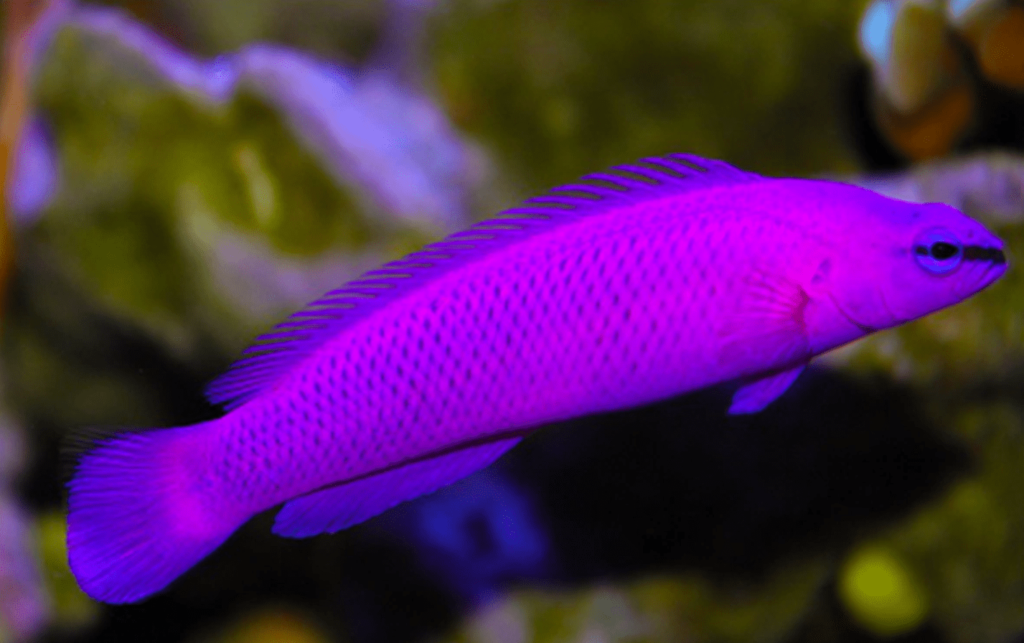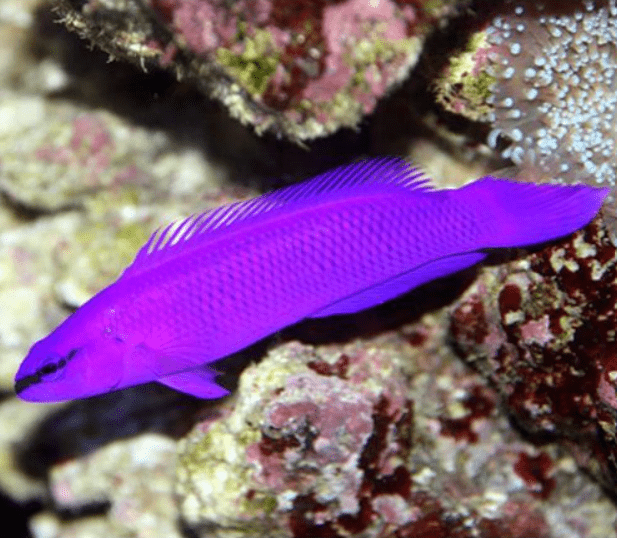Beautiful and mesmerizing, the Orchid Dottyback (Pseudochromis fridmani) is a marine fish found on the colorful coral reefs of the Red Sea. Marine scientists and aquarists love the Dottyback Orchid for its striking color and interesting temperament. This article examines the physical characteristics. The Dottyback Orchid’s habitat, behavior and conservation efforts explain why this species is so attractive and important to marine ecosystems.
Table of Contents
Orchid Dottyback Physical Characteristics

The Orchid Dottyback unusual appearance is well known. Bright purple or lilac colors of varying intensity give the fish a shiny appearance. The bright colors act as a deterrent to predators with a flashing warning signal. Just like how to hide among the equally beautiful coral. A long and slender body, allows this fish to move quickly through complex coral networks. Mature dotty back orchids are 7 to 9 centimeters (2.8 to 3.5 inches) long. Their distinctive, distinctive appearance is further enhanced by the distinctive black stripe that runs from The tip of the nose goes past the eyes, and ends at the gum area. Their fins are also brightly colored. Their anal, tail and dorsal fins are often a purple color mixed with their body color.
Orchid Dottyback Habitat and Distribution
Orchid Dottyback originate from coral reefs in the Red Sea. Commonly found in coastal areas of Saudi Arabia, Egypt and Sudan, these small but brightly colored fish find an ideal home in the complex and diverse reef ecosystem. The Dottyback orchid’s survival depends on the abundance of food supplies on the reef and its hiding places between coral crevices. Dottyback orchids often visit areas with dense coral growth and rocky surfaces at depths between 3 and 30 meters (10 and 100 feet). They can often be seen moving in and out of gaps. Navigate complex reef habitats with its small size and speed.
Orchid Dottyback Behavior and Diet
Dottyback Orchid’s behavior is one of its most interesting characteristics. This fish is assertive and possessive despite its small size. They are famous for fiercely defending their territory from invaders. even large fish Using aggression as a survival strategy helps them control breeding grounds and food sources. in nature, carnivorous Dottieback orchids mostly eat small invertebrates such as copepods, amphipods, and other small crustaceans. They hunt with quick reflexes and sharp eyesight. They often ambush their prey from behind coral structure. In captivity, they often add a variety of protein-rich foods, such as brine shrimp, mysis shrimp, and finely chopped clams. into their food
Orchid Dottyback Reproduction and Life Cycle
Another interesting aspect of the Dottyback Orchid’s biology is its reproductive habits. This fish can change from female to male. Because she is a prototype hermaphrodite This ability is very useful when the dominant male in the group disappears. To enable women to take control and ensure the survival of the population. Male Dottyback orchids create territories and build nests in corners or reef holes during the breeding season. The male then performs a courtship display. This usually includes a sudden change in color and display of fins. to attract the attention of females The male then mates with the eggs that the female deposits in the nest after accepting them. The incubation process usually takes 4 to 6 days, depending on water temperature. During that time, the male will protect the eggs. In the initial stages, plankton larvae follow the current until they are old enough to cling to the reef. When they grow up They find suitable areas on the reef to settle and live out their life cycle.
Orchid Dottyback Role in the Ecosystem
The reef environment relies heavily on the Dottyback Orchid. They help maintain the balance of the ecosystem by controlling the number of small invertebrates they feed on. Dottyback orchids protect their territory. This, in turn, prevents other species from overgrazing the coral. and contributes to the overall health of coral reefs. The Dottyback Orchid is also an important species for marine education and ecotourism due to its bright color and unique behavior. Divers and snorkelers are always on the lookout for these lively fish. This will help improve the local economy. and increase public awareness of the importance of protecting coral reefs.
Orchid Dottyback Conservation and Aquarium Trade

The Dottyback orchid’s habitat is threatened by human activities, although it is not currently considered an endangered species. Overfishing, pollution, and climate change are putting pressure on coral reefs in the Red Sea and around the world. Dottyback orchids aren’t the only species at risk of reef damage. Many other species also depend on this habitat for survival. Protecting coral reefs through conservation initiatives is critical to the future of Dottyback Orchid, an initiative to reduce pollution and carbon emissions. Marine-protected areas and sustainable fishing methods are important in reef conservation. The Dottyback Orchid is a highly sought-after species in the aquarium trade. This fish is known for its bright color and strong temperament. However, there are concerns about overfishing in the wild due to the high demand for this fish. Captive breeding programs are supported by many marine biologists and aquarists. To support the aquatic animal trade and reduce pressure on wild populations. Captive-reared Dottyback orchids are now widely accessible. And it is a great option for foodies who want to enjoy these amazing fish. without losing the population in the wild.
Conclusion
One of the most beautiful and diverse examples of marine life is the Dottieback orchid. It is a species worthy of research and conservation because of its distinctive color. interesting behavior And of great ecological importance, the Dottyback Orchid serves as a reminder of the complex and interconnected nature of marine life. As we continue to investigate and understand the complexity of coral reef ecosystems, By supporting conservation efforts and ethical practices, we can play our part in ensuring that these gem-like fish survive in their natural habitat for generations to come. in the fish tank